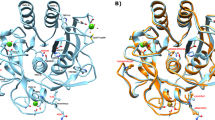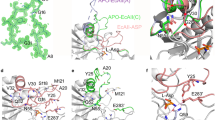Abstract
The Lysobacter enzymogenes α-lytic protease (αLP) is synthesized with a 166 amino acid pro region (Pro) that catalyzes the folding of the 198 amino acid protease into its native conformation. An extraordinary feature of this system is the very high energy barrier (ΔG = 30 kcal mol−1) that effectively prevents αLP from folding in the absence of Pro (t1/2 = 1800 years). A pair of mutations has been isolated in the protease that completely suppresses the catalytic defect incurred in Pro by truncation of its last three amino acids. These mutations also accelerate the folding of αLP in the absence of Pro by 400-fold. An energetic analysis of the two folding reactions indicates that the mutations stabilize the transition states of both the catalyzed and uncatalyzed folding reactions by 3 kcal mol−1. This finding points to a single transition state for these two distinct and energetically disparate folding pathways, and raises the possibility that all αLP folding pathways share the same transition state.
This is a preview of subscription content, access via your institution
Access options
Subscribe to this journal
Receive 12 print issues and online access
$189.00 per year
only $15.75 per issue
Buy this article
- Purchase on Springer Link
- Instant access to full article PDF
Prices may be subject to local taxes which are calculated during checkout



Similar content being viewed by others
References
Eder, J. & Fersht, A.R. Molec. Microbiol. 16 , 609–614 (1995).
Baker, D., Shiau, A.K. & Agard, D.A. Curr. Opin. Cell Biol. 5, 966 –970 (1993).
Shinde, U. & Inouye, M. Intramolecular chaperones and protein folding (R.G. Landes, Austin, Texas; 1995).
Cunningham, E.L., Jaswal, S.S., Sohl, J.L. & Agard, D.A. Proc. Natl. Acad. Sci. 0USA 96, 11008–11014 (1999).
Sohl, J.L. & Agard, D.A. In Intramolecular chaperones and protein folding (eds Shinde, U. & Inouye, M.) 61– 83 (R.G. Landes, Austin, Texas; 1995).
Baker, D., Silen, J.L. & Agard, D.A. Proteins 12, 339– 344 (1992).
Baker, D., Sohl, J.L. & Agard, D.A. Nature 356, 263– 265 (1992).
Sohl, J.L., Jaswal, S.S. & Agard, D.A. Nature 395, 817– 819 (1998).
Peters, R.J. et al. Biochemistry 37, 12058– 12067 (1998).
Baker, D. & Agard, D.A. Biochemistry 33, 7505–7509 (1994).
Chan, H.S. & Dill, K.A. Proteins 30, 2–33 (1998).
Dill, K.A. & Chan, H.S. Nature Struct. Biol. 4, 10–19 (1997).
Onuchic, J.N., Socci, N.D., Luthey-Schulten, Z. & Wolynes, P.S. Folding & Design 1, 441–450 (1996).
Bryngelson, J.D., Onuchic, J.N., Socci, N.D. & Wolynes, P.G. Proteins 21, 167–195 ( 1995).
Goldbeck, R.A., Thomas, Y.G., Chen, E., Esquerra, R.M. & Kliger, D.S. Proc. Natl. Acad. Sci. USA 96, 2782–2787 (1999).
Weissman, J.S. Chemistry & Biology 2, 255–260 (1995).
Tan, Y.J., Oliveberg, M. & Fersht, A.R. J. Mol. Biol. 264, 377– 389 (1996).
Burton, R.E., Huang, G.S., Daugherty, M.A., Calderone, T.L. & Oas, T. Nature Struct. Biol. 4, 305–310 (1997).
Wildegger, G. & Kiefhaber, T. J. Mol. Biol. 270, 294–304 (1997).
Martinez, J.C., Pisabarro, M.T. & Serrano, L. Nature Struct. Biol. 5, 721– 729 (1998).
Sohl, J.L., Shiau, A.K., Rader, S.D., Wilk, B.J. & Agard, D.A. Biochemistry 36, 3894– 3902 (1997).
Miller, J.H. A short course in bacterial genetics (Cold Spring Harbor Laboratory Press, Plainview, New York; 1992).
Brisette, J.L., Russel, M., Weiner, L. & Model, P. Proc Natl. Acad. Sci. USA 87, 862–866 ( 1990).
Lauder, S.D. & Kowalczykowski, S.C. J. Mol. Biol. 234, 72–86 (1993).
Bianco, P.R. & Weinstock, G.M. Nucleic Acids Res. 24, 4933–4939 (1996).
Mace, J.E. & Agard, D.A. J. Mol. Biol. 254, 720–736 (1995).
Mace, J.E., Wilk, B.J. & Agard, D.A. J. Mol. Biol. 251, 116– 134 (1995).
Acknowledgements
We thank E. Cunningham, J. Sohl, and B. Wilk for assistance in protein preparation, and R. Peters, J. Sohl, and A. Shiau for many helpful discussions. We thank D. Fraenkel and C. Gross for strains of E. coli from their laboratory collections, C. Gross for bacteriophage P1 and molecular biology reagents. DNA sequencing was performed at the Howard Hughes Medical Institute DNA Facility. E. Cunningham and S. Jaswal provided critical commentary on the manuscript. This work was supported by the Howard Hughes Medical Institute. A.I.D. was supported by postdoctoral fellowships from the American Cancer Society, the Howard Hughes Medical Institute, and a National Cancer Institute National Institutes of Health Institutional Training Grant administered through the Department of Biochemistry and Biophysics at UCSF.
Author information
Authors and Affiliations
Corresponding author
Rights and permissions
About this article
Cite this article
Derman, A., Agard, D. Two energetically disparate folding pathways of α-lytic protease share a single transition state. Nat Struct Mol Biol 7, 394–397 (2000). https://doi.org/10.1038/75172
Received:
Accepted:
Issue Date:
DOI: https://doi.org/10.1038/75172



